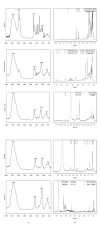Insights on the phytochemical profile (cyclopeptides) and biological activities of Calotropis procera latex organic fractions
- PMID: 24348174
- PMCID: PMC3852081
- DOI: 10.1155/2013/615454
Insights on the phytochemical profile (cyclopeptides) and biological activities of Calotropis procera latex organic fractions
Abstract
Calotropis procera is a medicinal plant whose pharmacological properties are associated with its latex. Here, the Calotropis procera latex fractions were investigated in an attempt to trace its phytochemical profile and measure its anti-inflammatory and toxicity activity. The crude latex was partitioned, yielding five fractions (49.4% hexane, 5.2% dichloromethane, 2.0% ethyl acetate, 2.1% n-butanol, and 41.1% aqueous). Phytochemical screening and spectroscopy analysis revealed that dichloromethane is the most chemically diverse fraction. Triterpenes were detected in both the hexane and dichloromethane fractions, while flavonoids were detected in the dichloromethane and ethyl acetate fractions. These fractions were cytotoxic to cancer cell lines (LD50 0.05 to 3.9 μ g/mL) and lethal to brine shrimp (LD50 10.9 to 65.7 μ g/mL). Reduced neutrophil migration in rats was observed in carrageenan-induced peritonitis for the dichloromethane (67%), ethyl acetate (56%), and aqueous (72%) fractions. A positive reaction with tolidine and ninhydrin suggested that cyclopeptides are in the ethyl acetate fraction. It is therefore concluded that Calotropis procera latex dichloromethane and ethyl acetate fractions exhibit both in vitro and in vivo activities as well as anti-inflammatory properties. Cyclopeptide detection is especially interesting because previous attempts to investigate these low-molecular cyclic amino acid sequences in C. procera have failed.
Figures
Similar articles
-
Cysteine Peptidases of Calotropis procera (Apocynaceae): A Literature Review on their Biochemical Properties and Potential Applications.Curr Protein Pept Sci. 2025;26(4):296-307. doi: 10.2174/0113892037340497241024095749. Curr Protein Pept Sci. 2025. PMID: 39722486 Review.
-
In Vivo Efficacy of Latex from Calotropis procera in Ameliorating Fever-Biochemical Characteristics and Plausible Mechanism.Appl Biochem Biotechnol. 2017 Jul;182(3):1229-1239. doi: 10.1007/s12010-016-2395-y. Epub 2017 Jan 11. Appl Biochem Biotechnol. 2017. PMID: 28078650
-
In-vivo anti-plasmodial activity of phosphate buffer extract of Calotropis procera latex in mice infected with Plasmodium berghei.J Ethnopharmacol. 2021 Sep 15;277:114237. doi: 10.1016/j.jep.2021.114237. Epub 2021 May 27. J Ethnopharmacol. 2021. PMID: 34051335
-
Wound-healing and potential anti-keloidal properties of the latex of Calotropis procera (Aiton) Asclepiadaceae in rabbits.Afr J Tradit Complement Altern Med. 2013 Apr 12;10(3):574-9. eCollection 2013. Afr J Tradit Complement Altern Med. 2013. PMID: 24146491 Free PMC article.
-
Calotropis procera and the Pharmacological Properties of Its Aqueous Leaf Extract: A Review.Cureus. 2024 May 15;16(5):e60354. doi: 10.7759/cureus.60354. eCollection 2024 May. Cureus. 2024. PMID: 38883127 Free PMC article. Review.
Cited by
-
A review on phytochemical constituents and pharmacological potential of Calotropis procera.RSC Adv. 2021 Nov 4;11(57):35854-35878. doi: 10.1039/d1ra06703f. eCollection 2021 Nov 4. RSC Adv. 2021. PMID: 35492791 Free PMC article. Review.
-
Sustainable Development of Chitosan/Calotropis procera-Based Hydrogels to Stimulate Formation of Granulation Tissue and Angiogenesis in Wound Healing Applications.Molecules. 2021 May 29;26(11):3284. doi: 10.3390/molecules26113284. Molecules. 2021. PMID: 34072397 Free PMC article.
-
Tap the sap - investigation of latex-bearing plants in the search of potential anticancer biopharmaceuticals.Front Plant Sci. 2022 Nov 1;13:979678. doi: 10.3389/fpls.2022.979678. eCollection 2022. Front Plant Sci. 2022. PMID: 36388598 Free PMC article. Review.
-
Phytochemical Investigations and Pharmacological Potential of Organic Extracts of Calotropis gigantea L. Leaves.Scientifica (Cairo). 2025 Jul 8;2025:1669969. doi: 10.1155/sci5/1669969. eCollection 2025. Scientifica (Cairo). 2025. PMID: 40666498 Free PMC article.
-
Cysteine Peptidases of Calotropis procera (Apocynaceae): A Literature Review on their Biochemical Properties and Potential Applications.Curr Protein Pept Sci. 2025;26(4):296-307. doi: 10.2174/0113892037340497241024095749. Curr Protein Pept Sci. 2025. PMID: 39722486 Review.
References
-
- Chundattu SJ, Agrawal VK, Ganesh N. Phytochemical investigation of Calotropis procera . Arabian Journal of Chemistry. 2011
-
- Kumar VL, Arya S. Medicinal uses and pharmacological properties of Calotropis procera . In: Govil JN, editor. Recent Progress in Medicinal Planta. Vol. 11. Texas Studium Press; 2006. pp. 373–388.
-
- Oh SK, Kang H, Shin DH, Yang J, Han KH. Molecular cloning and characterization of a functional cDNA clone encoding isopentenyl diphosphate isomerase from Hevea brasiliensis. Journal of Plant Physiology. 2000;157(5):549–557.
MeSH terms
Substances
LinkOut - more resources
Full Text Sources
Other Literature Sources
Research Materials



